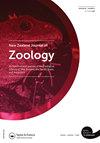圈养汉密尔顿蛙(Leiopelma hamiltoni)在静修场所下非随机联想:对其社交网络的初步见解
IF 1.1
4区 生物学
Q3 ZOOLOGY
引用次数: 1
摘要
摘要汉密尔顿蛙(Leiopelmahamiltoni)经常被发现在野外和圈养的休养地共同居住,但共同居住是否是社会性的一个方面还有待探索。我们使用社交网络框架调查了四个圈养的L.hamiltoni群落中撤退地点共享的关联模式。我们测试了每个网络的个体之间的关联强度和异质性是否与预期不同,或者青蛙是否随机共享撤退地点。我们还研究了成对关联的时间稳定性。在所有的坦克中,我们发现青蛙共享的撤退地点比预期的要多得多,如果它们没有表现出任何程度的关联。此外,我们观察到比随机预期的更优选和避免的配对。坦克内成对个体之间的时间稳定性在短时间内(10-50天)是稳定的,但随着时间的推移会下降。然而,坦克内部和坦克之间的高度变化使我们无法在时间稳定性方面建立明显的趋势。我们的研究结果表明,圈养的L.hamiltoni蛙,至少在短期内,优先选择与特定个体的撤退地点,由此我们推断,撤退地点共享形式的社会性可能构成L.hamiltani生物学的关键组成部分。本文章由计算机程序翻译,如有差异,请以英文原文为准。
Captive Hamilton’s frog (Leiopelma hamiltoni) associates non-randomly under retreat sites: preliminary insights into their social networks
ABSTRACT Hamilton’s frog (Leiopelma hamiltoni) is often found co-habiting retreat sites in the wild and in captivity, but whether co-habitation is a facet of sociality remains to be explored. We investigated the association patterns of retreat site sharing in four captive colonies of L. hamiltoni using a social networking framework. We tested whether the strength and heterogeneity of associations between individuals of each network varied from expected, or if frogs shared retreat sites randomly. We also investigated the temporal stability of pair-wise associations. In all tanks, we found that frogs shared retreat sites significantly more than would be expected if they displayed no degree of association. Further, we observed more preferred and avoided pairings than would be expected at random. Temporal stability between pairs of individuals within a tank were stable over short time periods (10–50 days) but decreased over time. High variation within and between tanks, however, prevented us from establishing a clear trend in temporal stability. Our results suggest that captive L. hamiltoni frogs, at least over the short-term, preferentially select retreat sites with specific individuals, and from this we infer that sociality in the form of retreat site sharing may form a key component of L. hamiltoni biology.
求助全文
通过发布文献求助,成功后即可免费获取论文全文。
去求助
来源期刊
CiteScore
2.80
自引率
0.00%
发文量
20
审稿时长
>12 weeks
期刊介绍:
Aims: The diversity of the fauna of the southern continents and oceans is of worldwide interest to researchers in universities, museums, and other centres. The New Zealand Journal of Zoology plays an important role in disseminating information on field-based, experimental, and theoretical research on the zoology of the region.

 求助内容:
求助内容: 应助结果提醒方式:
应助结果提醒方式:


